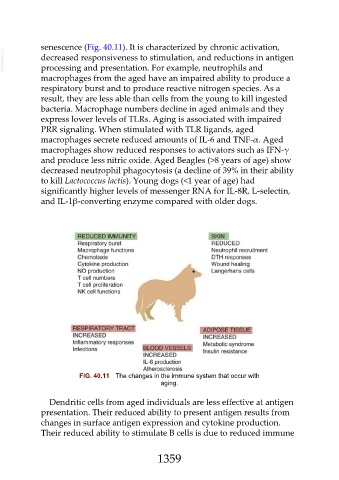Page 1359 - Veterinary Immunology, 10th Edition
P. 1359
senescence (Fig. 40.11). It is characterized by chronic activation,
VetBooks.ir decreased responsiveness to stimulation, and reductions in antigen
processing and presentation. For example, neutrophils and
macrophages from the aged have an impaired ability to produce a
respiratory burst and to produce reactive nitrogen species. As a
result, they are less able than cells from the young to kill ingested
bacteria. Macrophage numbers decline in aged animals and they
express lower levels of TLRs. Aging is associated with impaired
PRR signaling. When stimulated with TLR ligands, aged
macrophages secrete reduced amounts of IL-6 and TNF-α. Aged
macrophages show reduced responses to activators such as IFN-γ
and produce less nitric oxide. Aged Beagles (>8 years of age) show
decreased neutrophil phagocytosis (a decline of 39% in their ability
to kill Lactococcus lactis). Young dogs (<1 year of age) had
significantly higher levels of messenger RNA for IL-8R, L-selectin,
and IL-1β-converting enzyme compared with older dogs.
FIG. 40.11 The changes in the immune system that occur with
aging.
Dendritic cells from aged individuals are less effective at antigen
presentation. Their reduced ability to present antigen results from
changes in surface antigen expression and cytokine production.
Their reduced ability to stimulate B cells is due to reduced immune
1359

